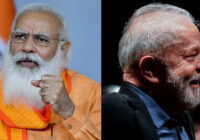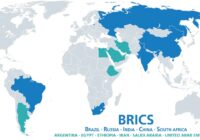If, after nine years, BRICS remains a disparate grouping, it will soon be time to explore new avenues of cooperation.
It is ironic that trade and investment flows within BRICS countries—Brazil, Russia, India, China and South Africa—continue to disappoint, even though economics was the primary reason for the formation of the grouping.
Nine years after BRICS came into existence, none of its member states figure high on the list of export destinations of other BRICS countries. India’s trade data exemplifies this poor record. Provisional data for 2014-15 (April-March) shows India’s merchandise exports to other BRICS countries totaled only $25.1 billion, a paltry 8.1% of the total export receipts of $309 billion. Among all the export destinations for India, China was fourth (with exports of $11.9 billion), Brazil at 13th ($5.9 billion), South Africa at 18th ($5.3 billion) and Russia at 38th ($2.1 billion). The situation is similar for all the other BRICS countries.
At the same time, the five member countries do need meeting points beyond trade and capital flows if BRICS is to build greater cohesion and propagate an alternative development doctrine. Culture and education can be the necessary cement to enhance cooperation and coordination, and the New Development Bank (NDB) can play a significant role in this task.
The NDB, popularly known as the BRICS Bank and created during the sixth BRICS Summit in 2014, is expected to provide a development financing model that is different from the template used by the World Bank or the International Monetary Fund (IMF). It will be headquartered in Shanghai, and the five BRICS countries will be its major shareholders.
Culture
Culture is a particularly opportune area because most BRICS countries have historical or even ancient ties with one another. For example, the Chinese scholar Xuanzang journeyed through India for 17 years between 600-700 AD. The famous Wild Goose Pagoda in Xian, which was built to honor Xuanzang, is where Indian Prime Minister Narendra Modi started his China visit in May.
Many other BRICS members boast of traditional and historical links. For instance, India, China and Russia were all connected by the ancient Silk Route, which was a corridor not only for trade, but also for religions and philosophies. Brazil and India were linked 500 years ago by Portuguese marine expansion.
More recently. BRICS countries have participated in cultural exchange programs through reciprocal visits by performing artists or exchanges of art works. Often, however, these exchanges are burdened by an “exotica” tag and tend to target only the cognoscenti. At times, they also get lost in the procession of routine exchanges with non-BRICS members. In other words, there is no special focus or flavor to cultural exchanges specifically between BRICS countries.
At the BRICS Academic Forum in May, one of the suggestions put forth was to improve the access of translated literature from various BRICS territories. All of these are certainly necessary, but they are not sufficient conditions.
Instead, the focus can shift to one of the most enduring forms of cultural exchanges: people-to-people contact. In a fast-globalizing world, widespread tourism can be a way to increase contact between the citizens of BRICS countries.
Promoting tourism with determination will help to intensify already-existing tourist flows. For this, BRICS must make a few catalytic decisions, and one of the necessary steps is already being implemented: Some BRICS countries are relaxing visa requirements and the results are showing. Brazil and Russia introduced a visa waiver program in 2010. Consequently, the number of Brazilians visiting Russia almost doubled from 15,000 in 2010 to 30,000 in 2013. A similar agreement between Brazil and South Africa has also yielded positive results. In 2013, China allowed Brazilian and Russian passport holders to spend 72 hours in Beijing or Shanghai without a visa.
New Delhi does not have similar agreements with BRICS partners yet, though India has provided an e-visa facility since November 2014 to Brazilian and Russian tourists, and Modi announced the e-facility for Chinese tourists during his visit to China.
At the same time, the number of outbound tourists from India is increasing every year. In 2013, 677,000 Indians visited China and 106,000 went to South Africa. Indians were ranked 16th among arriving foreign tourists in Russia that year. These developments have now prompted South Africa to ease visa norms for Indians.
With BRICS countries constituting around 40% of the world’s population, the potential for intra-BRICS flows of people is tremendous. But to realize this promise, investments are necessary in policy-level initiatives as well as physical infrastructure.
Some policy measures have already been taken. The “Incredible India” program—an international marketing campaign launched by the Indian government in 2002 to project India as a tourist destination—covers various types of tourism, including medical, sports, adventure and wellness.
However, only Russia and China figured among the top 15 countries of the foreign tourist arrivals of 7.7 million in 2014. Although this total figure represents a growth of 10.6% over 2013, India can do a lot more to attract BRICS tourists, starting with easing visa regulations and cutting down on the delays in issuing visas.
China and Russia have also introduced policy interventions. For example, in 2013, the Chinese government published a tourism strategy paper titled The Outline for National Tourism and Leisure (2013-2020). The study focuses on increasing foreign tourist arrivals in China, which grew only marginally from 55.66 million in 2000 to 55.68 million in 2013, through higher investment in infrastructure and better regulation.
Russia developed a new federal tourism development program in 2011 to improve its image as a tourist destination and to stimulate foreign investment in tourism infrastructure. Initial results look promising: 30.7 million trips were made in 2013, compared with 22.2 million in 2010, showing double-digit growth.
The New Development Bank has a definite role here. Numerous tourist destinations need investment in infrastructure—roads to drive, facilities like hotels and motels, and rail and aviation infrastructure linking the multiple BRICS centers. Given that the NDB is expected to devise new paradigms of project appraisal and risk assessment and mitigation, it should also include finance for developing tourism infrastructure and funding for restoration and preservation of heritage sites.
Two economic reasons—apart from bringing BRICS nations closer—will justify the NDB’s focus on tourism financing. First, the existing multilateral agencies do not pay much attention to such financing, thereby leaving a gap for institutions like the NDB. Second, given the proven link between rising tourism revenues and economic growth, the NDB must pursue tourism financing as a part of its program of fostering sustainable economic growth.
Focusing on Education
Education is another potential area of enhanced cooperation within the grouping. BRICS countries account for one in three students in the world. But the major challenge for all BRICS nations is not only providing education for all, but providing high-quality education for all.
Although most member countries have plans to overhaul their education systems to meet the growing demand, most outbound students from BRICS enroll in universities in the West. This is unlikely to change soon. In 2014, the US was the main destination for 210,000 Chinese students, 97,000 Indian students and 9,000 Brazilian students. Other key destinations include Britain, Japan, Australia and Germany.
Over the past decade, BRICS nations have also emerged as an important destination for foreign students: Russia leads with 174,000 students, followed by China with 89,000, South Africa with 70,000, India 31,000 and Brazil 14,000.
Recognizing the need to cooperate on education, the July 2014 communiqué issued at the BRICS Summit stated:
“We reaffirm our commitment to accelerating progress in attaining the Education for All goals and education-related Millennium Development Goals by 2015 and stress that the development agenda beyond 2015 should build on these goals to ensure equitable, inclusive and quality education and lifelong learning for all. We are willing to strengthen intra-BRICS cooperation in the area … We intend to continue cooperation with relevant international organizations. We encourage the initiative to establish the BRICS Network University.”
In a similar vein, a report of a round-table meeting of BRICS education ministers in Paris, in November 2013, convened by the United Nations Educational, Scientific and Cultural Organisation (UNESCO), stated: “The diversity of their policy experiences implies that BRICS can learn from one another: policies that have proven successful in one country could be adopted in another. In particular, the five countries would gain from cooperating in areas where they face common challenges, such as organizing and financing skills development, and positioning their higher education and research institutions on the global stage.”
Participants at the UNESCO meeting agreed that BRICS would gain by encouraging student mobility within member nations. In keeping with this view, the proposed BRICS Network University aims to attract students from fellow BRICS nations and further strengthen people-to-people contact. The Network University will enable universities in the group to collaborate on the development and teaching of courses; it will also enable mutual recognition of qualifications and the transfer of credits between participating institutions.
But before establishing a university, BRICS countries must first outline a strategy on cooperation in education and clarify what the university will work to achieve. The South Asian University, which was initiated in 2010 South Asian Association for Regional Cooperation (SAARC), has not been very successful in attracting students from SAARC countries. This failure should be examined before embarking on a similar endeavor.
Meanwhile, BRICS countries can exchange notes and experiences about how equity and quality in publicly-funded schools can be increased through better governance and financing mechanisms. There have also been demands to increase cooperation in technical and vocational training.
Over time, the NDB can be used to not only deepen education initiatives within each BRICS country and assist in cross-pollination, but to also use BRICS’ institutional knowledge and best practices for improving the education infrastructure in non-BRICS countries. The UNESCO report endorses this potential: “BRICS are also increasingly engaged in development cooperation with low and middle income countries. Sharing experiences in providing technical assistance and funding projects in other countries could help each BRICS country to improve the effectiveness of its cooperation programmes and deepen their impact.”
Since few Western multilateral institutions finance educational institutions in poor countries, the NDB could also develop a model for financing the development of a robust educational model within BRICS and other developing and least developed countries. The repayment schedule, the responsibility for repayment and the guarantee conditions (preferably by a sovereign) for the loan can be the distinctive features of the NDB model.
Nine years have after the first meeting of BRICS foreign ministers in 2006, and despite structured discussions and periodic meetings between different levels of the decision-making apparatus, a lot remains to be done.
First, the trade and investment flows between BRICS countries must be accelerated. Trade and finance ministers from the five countries have already agreed on the draft of the “BRICS Economic Cooperation Strategy” and are working on a road-map to implement the proposals.
Second, the NDB must adapt an alternative financial architecture that takes cognizance of non-conventional development models, such as local livelihood projects, informal marketplaces and the rightful place of micro, small and medium-sized enterprises.
Expedited economic engagement through trade and capital flows, combined with cultural and educational cooperation, all energized and accelerated by the NDB, can help bring BRICS countries closer and strengthen their resolve to create a new development paradigm.
*[This article was originally published by Fair Observer’s content partner, Gateway House.]
The views expressed in this article are the author’s own and do not necessarily reflect Fair Observer’s editorial policy.
Photo Credit: Kremlin / Roberto Stuckert Filho
 We bring you perspectives from around the world. Help us to inform and educate. Your donation is tax-deductible. Join over 400 people to become a donor or you could choose to be a sponsor.
We bring you perspectives from around the world. Help us to inform and educate. Your donation is tax-deductible. Join over 400 people to become a donor or you could choose to be a sponsor.
Support Fair Observer
We rely on your support for our independence, diversity and quality.
For more than 10 years, Fair Observer has been free, fair and independent. No billionaire owns us, no advertisers control us. We are a reader-supported nonprofit. Unlike many other publications, we keep our content free for readers regardless of where they live or whether they can afford to pay. We have no paywalls and no ads.
In the post-truth era of fake news, echo chambers and filter bubbles, we publish a plurality of perspectives from around the world. Anyone can publish with us, but everyone goes through a rigorous editorial process. So, you get fact-checked, well-reasoned content instead of noise.
We publish 2,500+ voices from 90+ countries. We also conduct education and training programs
on subjects ranging from digital media and journalism to writing and critical thinking. This
doesn’t come cheap. Servers, editors, trainers and web developers cost
money.
Please consider supporting us on a regular basis as a recurring donor or a
sustaining member.
Will you support FO’s journalism?
We rely on your support for our independence, diversity and quality.








Comment